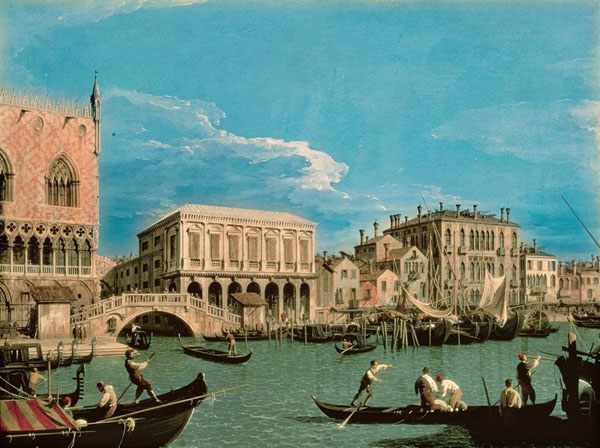120. The Riva degli Schiavoni,
Venice (The Bridge of Sighs), c. 1740.
Oil on canvas. Toledo Museum of Art, Toledo.
He must have regretted not having discovered in Canaletto an uncle similar to the one Marco Ricci encountered in that extraordinary traveller who was brother to his father, Sebastiano Ricci. He was a tireless itinerant who had travelled throughout Italy, having copied the Carracci works from the Farnese palace in Rome for Duke Ranuccio of Parma. He then went to Germany to paint, and then on to Vienna where he decorated The Schönbrunn Palace. After that, he went back to Florence, where he worked for the great Duke of Tuscany, then on to England, to work for Queen Anne, and then Paris, for the King. There, the Royal Academy of Painting gave him a very warm welcome. In the end, he came back to Venice to die, decorated with possessions and honours. Upon reaching the proper age, his nephew Marco accompanied him on his travels throughout every country in Europe, assisting him with his paintings of architecture.
Bellotto would have loved to assist such an adventurous kind of uncle because he liked to travel. He also regretted that he was not able to be his relative’s servant squire, except momentarily and by chance in London, because he had left Venice before he had had the opportunity. It seems that he was driven to self-exile for a large part of his life. Faithful to the tradition that every Italian painter had to start his career with a visit to Rome, where great teaching abounded, he departed for that city where, at the time, true artists became established. It was the necessary complement to all of his training.
Neither the fascinating life of the lagoons, nor the passionate arguments that pitted Goldoni, thirty-six, and Chiari, seven years older, against one another, nor even the welcome he must have experienced in the salons of the brilliant Luisa Bergalli, Gozzi’s wife, nor the assumed friendship of Tiepolo, the son, could keep him in his native city. He arrived in Rome with a letter of recommendation written by his uncle to Pannini, who had become more and more interested in his landscapes that depicted scattered ruins, pastoral characters and solitary warriors and who was certainly in a position to give the young artist advice.
In the Eternal City, Bellotto was revealing his excessive vanity, his taste for ostentation and his pride about being the new master of painting in relief. He sincerely believed that he was an adventurous gentleman. Not long after that, he was quick to confer the title of Count upon himself. That ruse went without consequence; so he did that kind of thing often. His intense curiosity compelled him to look for art everywhere. He returned to Venice where he painted the boat ramp, and then he stayed in Brescia, Pavia, Turin and Milan where he sketched and painted. He persistently sought patronage from the powerful and pursued the easiest roads to royal palaces in order to amass titles and pensions. He was a great social climber, even though social climbing was something that was hardly acknowledged during his day.
